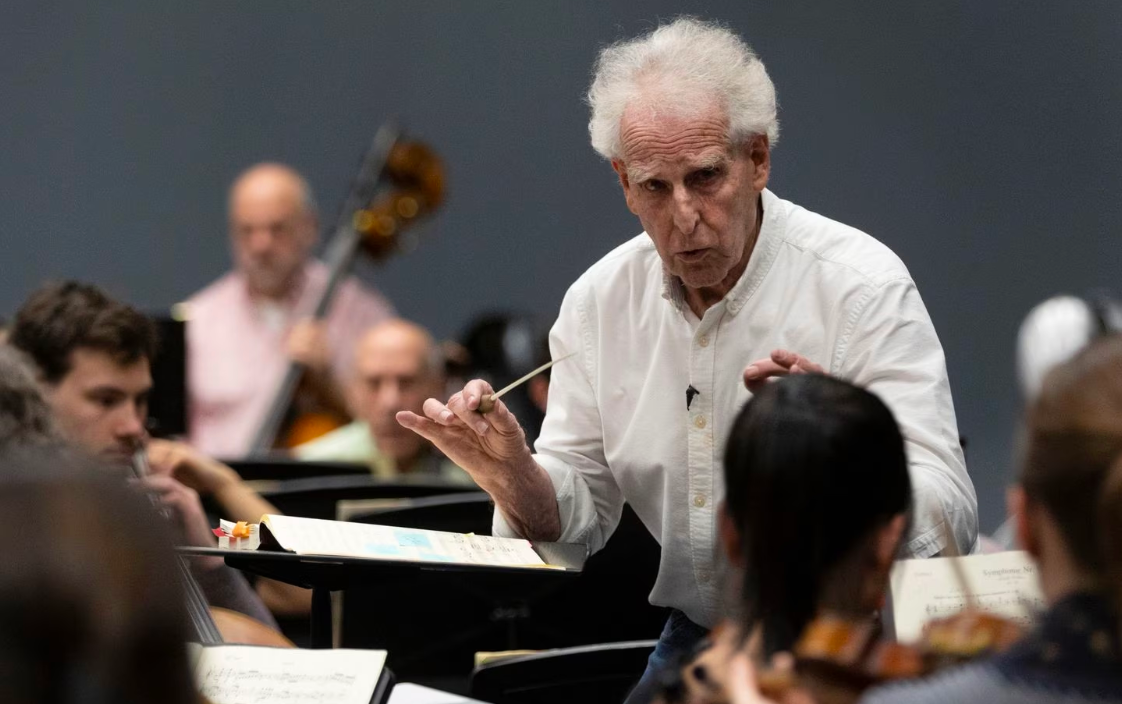Beethoven’s Ninth as its composer intended

The symphony was never meant to be a slow-paced dirge. Benjamin Zander, of the Boston Philharmonic, has spent half his life trying to prove it.
Because of Beethoven’s deafness, the great composer never got to hear his Symphony No. 9, with its beloved “Ode To Joy” movement, performed the way he wrote it: from start to finish, a crisp 58 minutes. The symphony typically clocks in at 75 to 82 minutes.
Few realize that after Beethoven’s death, no one else heard it the way he wrote it, either. That is, until conductor and musicologist Benjamin Zander premiered his ultra-fast Beethoven’s Ninth in London in 2017, with the Philharmonia Orchestra and Chorus at Royal Festival Hall.
Tonight, Zander will lead his own orchestra, the Boston Philharmonic, through an equally swift performance at Symphony Hall. Sunday, he’ll do it again at Carnegie Hall in New York.
I had the privilege of singing in the chorus in London and will perform it again at Carnegie Hall. This required me to unlearn the traditional, incorrect approach to “Ode to Joy” and to learn to sing it Zander-style, which means fast and furious, not dirge-paced and lugubrious. The experience of singing it that way borders on the sensual, as I take in breath and turn it into Beethoven. It also creates an extraordinary sense of connection with old Ludwig V.
Zander, 83, has dedicated almost half his life to studying Beethoven’s Ninth. “If Beethoven were to hear what most conductors are doing to his greatest masterpiece, he would explode in fury,” Zander says. “Do you think he didn’t care?” The composer, he adds, was a noted perfectionist.
In studying scores of scores, Zander discovered that so many mistakes have crept into Beethoven’s original that the symphony takes far too long to play. “The energy is just sapped from the piece,” Zander says. “No wonder audiences sleep through classical music performances.”
And so Zander has made it his life’s work to restore the Ninth to Beethoven’s original intent. “My goal,” he says, “has been to examine the best musicological evidence of what Beethoven actually wrote, and then try to make sense of it, rather than tossing it out as rubbish because it doesn’t seem to fit the mold.”
The key to solving the mystery, Zander says, was the metronome, a device invented while Beethoven was still composing and one he loved at first tick. Or tock.
“The metronome allowed Beethoven to indicate exactly how he wanted every measure of every piece to be performed,” Zander explains. “His actual words were these: ‘I look upon the invention of the metronome as a welcome means of assuring the performance of my compositions everywhere in the tempi conceived by me, which to my regret have so often been misunderstood.’”
Why should Beethoven have been so enamored of a simple device despised ever since by two centuries of young piano students? Prior to the metronome, composers would indicate, usually in Italian, the speeds at which they wanted conductors to conduct their works. Such terms as vivace (brisk and lively), allegro (quickly and bright), and prestissimo (very quickly, or, Jane! Stop this crazy thing!) were subject to the whims of the conductors, who took whatever pace suited them, the composer’s desires be damned.
Beethoven mistakenly thought that if they were using a metronome, conductors would have no choice but to play his pieces the way he wanted them played. He was wrong. Over time, Zander came to learn, conductors ignored Beethoven’s commands even though they weren’t just spelled out in Italian — they had precise beats per minute specified for practically every bar of the Ninth Symphony. Compounding matters, Zander learned, music printers misunderstood and misprinted Beethoven’s instructions, making an ever greater muddle of things. It took Zander decades to find all the errors that had been driving all those 80-minute performances of the Ninth.
“The performance in London allowed us all to hear the Ninth the way it was supposed to be heard — with life, with spirit, with brio. That’s the real Beethoven!” Zander says. And with his most recent performances, Zander is adding a twist, playing with what musicians call tempo rubato, which means creating irregular beats within the framework of the overall piece. A bit slower here, a bit faster there, all while adhering to the composer’s wishes.
For the audiences trained by conductors over the decades to yawn through the Ninth, the performances also offer a thrill. In London, all 3,000 in attendance went berserk. There’s no other way to put it. When it was suddenly over — and the end of the Ninth comes suddenly, to the performers and to the audience — they burst into the most rousing ovations I have ever heard.
They, too, knew they’d heard something unlike anything they’d heard before. And like those of us on stage, they felt more connected to Beethoven.
Zander, for his part, came away invigorated and triumphant. “I imagine that Beethoven is always listening to what we are doing,” he told me after the performance. “I’d like to believe that he’s aware of our efforts. Somewhere, he’s saying, ‘Finally!’”
Click here to view the Beethoven Symphony no. 9 Collection
 Michael Levin - The Boston Globe
Michael Levin - The Boston Globe